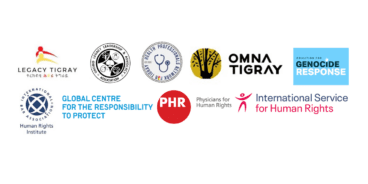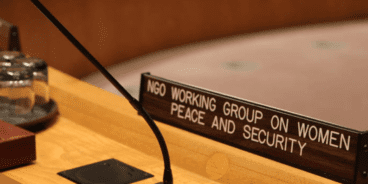
The Responsibility to Protect, The Next Five Years: Agreeing on the Road Map, 2nd Annual Ministerial Meeting Summary
On 25 September 2009, a group of ministers and senior government officials met to discuss what they see as the five year road map for realizing the responsibility to protect. In opening their remarks, all participants agreed that there had been significant progress on the responsibility to protect in the past twelve months, most notably in the very widespread support for the Secretary General’s report in the July 2009 General Assembly debate, and the adoption by consensus of the first resolution on R2P since the 2005 summit. This offered a solid footing for the essential – and overdue – step to implement the 2005 commitment.
The following aspects of a roadmap emerged from the discussion.
The importance of sustained political leadership and advocacy
The level of attendance at the meeting was noted as testament to the shared belief that a cohesive, cross-regional group of ministerial advocates, sharing a common vision and committed to an agreed set of goals, can play a fundamental role in the realization and consolidation of this emerging norm. Sustaining and increasing such political leadership is crucial to see that action is taken to save lives.
One participant cautioned that while very positive, the GA debate suggested that the support for R2P was “broad rather than deep,” thus highlighting the importance of sustained advocacy on R2P. Others noted the ongoing challenge to overcome misperceptions and mistrust, requiring consistent communication about what R2P is—and is not. This includes stressing that national obligations are primary, and international ones are secondary, speaking about R2P in human terms, spelling out the consequences for real people of fulfilling—or failing—in the responsibility to protect from mass atrocity crimes.
Several participants supported the proposal that the current roundtable discussion should become an annual event during the high level segment of the opening of the GA, and that such meetings should also be replicated on the margins of other major multilateral events which bring ministers together – whether at the African Union, ASEAN, meetings of the Non Alignment Movement, Rio Group and others One minister entreated the rest to make frequent public references to R2P in international fora, underlining that it is a priority, offering a recent opinion piece drafted by two foreign ministers as an instructive example of what a group of likeminded ministers should be doing.
Many noted the vital role of NGOs in this process of deepening the commitment to R2P, and the need to support civil society initiatives to advance and promote R2P.
The norm of R2P should be consolidated through practice
Something of a consensus emerged on the need to consolidate the responsibility to protect through practice, with some noting that it is action to save lives—and not rhetorical references to the responsibility to protect –that is the most important.
While one participant noted that the General Assembly was the premier forum to consolidate the norm, there appeared to be little appetite to push the GA on this any time soon. Rather, emphasis was put on the need for ongoing outreach.
Though several speakers referred to the principle of R2P, there were signs of widespread agreement with the assertion of one participant that it was more accurate to talk about a norm, not a concept, given R2P’s status in 3 UNSC resolutions.
R2P needs to be “mainstreamed” inside regional institutions
On the question of whether and how to advance the norm at the regional level, it was noted that R2P already had a solid foundation within the African Union, and that the efforts to “mainstream” R2P within the various institutions of the European Union could yield instructive lessons for other regional organizations. In East Asia, commitment is emerging to build norms and capacities at the regional level to prevent conflict—and thereby avoid external intervention—suggesting that R2P advocates should engage to ensure there is a corresponding focus on preventing mass atrocities within these efforts.
The priority for Security Council reform is to press the P5 to agree to withhold their veto in situations of mass atrocity
Many participants stressed that it was crucial that the Security Council discharge its unique responsibilities to protect to address the “confidence deficit” or underlying lack of trust among some member states about R2P. Core to this was the P5 withholding their vetoes in situations of mass atrocity. A smaller number agreed that it was necessary to achieve progress on triggering Security Council attention to situations of potential mass atrocity crimes, though explicit suggestions of how to do this were not offered, except to note the ongoing efforts of the “S5” to promote reform of the Council’s working methods and procedures, or that the GA should use Resolution 377 “Uniting for Peace”—in instances where the Council was not acting effectively, with a view to making appropriate recommendations about collective measures. One participant referred to the need for the General Assembly to agree to principles to guide the use of force.
Support and monitor national efforts at good governance and upholding the rule of law
On the question of national level action, several speakers noted that national commitment to good governance and the rule of law is a reliable indicator of commitment to fulfill the fundamental obligations that sovereign states have to protect their own populations from mass atrocity crimes. Simply put, states internalizing international standards and thus upholding the rule of law is the best route to preventing mass atrocity crimes. States that cannot do this should be prepared to ask for help and the international community should correspondingly be ready to provide resources for this. One participant drew on their own national experience to highlight the importance of requesting and receiving timely and appropriate assistance in security sector reform.
Conversely, the breakdown of good governance and rule of law are early warning indicators of the potential for mass atrocities to occur. The African Peer Review Mechanism was cited as one potential mechanism for such monitoring.
Prioritize capacity building at the sub-regional, regional and UN level
Those capacities that emerged as priorities for the participants included:
-
-
- Those of regional and sub-regional organizations, with a particular emphasis on early warning, standby capacities and mediation capacities;
- Early warning procedures of both national bureaucracies and the UN to ensure greater “policy coherence” between varying departments, agencies and players that may receive sources of information of possible or impending mass atrocities in order to trigger the necessary action more consistently.
- The mediation capacities of the Secretary-General and the UN;
- Military capabilities, including, but not solely within the African Union, given experiences such as that of East Timor or Sierra Leone, where military intervention proved crucial to save lives.
-
Many stressed the importance of ensuring that the UN has the capacity to take effective actions when a state is manifestly failing in its responsibility –the third pillar –not least because this was necessary to save lives, but also to serve as a deterrent to those contemplating perpetrating mass atrocity crimes.
Enhance interaction and collaboration among countries on early warning and response
Several participants stressed the urgency they attached to optimizing the sharing of information and intelligence in real time situations where people are at risk of mass atrocities. Emphasis was put on the need to have better analysis and thus advance knowledge of the potential for perpetration of mass atrocities in specific situations to enable greater thought about what levers to use and what action to take.
Within Africa, some sub-regional institutions are already engaged in discussions about regional defense and early warning, offering another important forum to ensure sufficient attention is focused emerging threats of mass atrocities and timely preventive action. Inter-regional collaboration, within Africa and beyond, was also emphasized. One participant argued that the Peace and Security Council of the African Union should be considered an ally to those seeking to realize the responsibility to protect.
Research is required to provide greater clarity on the specific interventions and strategies that prevent and halt mass atrocities and to provide answers on what is best practice
A couple of participants argued that it was necessary to get greater clarity on R2P-specific interventions and capacities i.e. the distinct measures and tools that are specifically required to prevent and halt mass atrocity crimes, whilst also ensuring policy coherence with efforts related to, but not solely focused upon realizing R2P. For example, in the past year there have been separate processes pressing to strengthen mediation, the UN Department of Political Affairs, peacekeeping, improve system wide coherence, and tackle sexual violence in armed conflict, all of which could have a bearing on fulfilling R2P but which go beyond it. There is also a need to “fine tune” the distinct strategies required for early prevention, the prevention of early violence and effective responses in settings of ongoing violence. Some noted the benefits of region-to-region learning. One participant stressed that the International Criminal Court is perhaps the key “tool in the toolbox” to realize the responsibility to protect.
Instructive case studies of when R2P has been applied are also considered essential to build commitment to R2P. The Global Centre was asked to compile examples that are slowly building practice of R2P.

